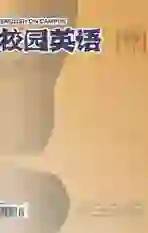Research Methods and Strategies of Children’s Literature and Children’s Literature Translation in China
2018-01-05JiangTingTing
Jiang Ting Ting
【Abstract】The growth of the children has received a great deal of concern from the whole world. The childrens literature, a part of childrens spiritual life, also get a lot of experts and scholars attention. The paper tries to introduce the definition and the origin of the CL, and to analyse the state, the theoretical basis and translation strategies of CLT. In a word, the paper hopes to make a contribution to the CLT in the future.
【Key words】the Childrens literature; Childrens literature translation; theory; strategy
【作者簡介】江婷婷(1981.10-),女,汉族,江苏连云港人,连云港师范学院语言与商学院,讲师,硕士学位,研究方向:翻译理论与研究。
Childhood is claimed as a golden and crucial period in a mans life. Childrens literature (CL for short) has a profound and critical influence on their childhood, containing the influence on their language acquisition, their ability of creativity and imagination, their appreciation of beauty and the shaping of good personality. It is well-known that reading the foreign childrens literature translation (CLT for short) is an effective and efficient way to broaden children readers horizon. Nowadays, translation research has received more and more attention in China.
1. Research Review of CL and CLT in China
China is a long-history country, and its cultural tradition lasts for several thousand years. The development of CL parallels the history of CLT in China since the Qing Dynasty, and it is closely connected with excellent foreign CL. However, Chinas CLT has not received as much attention as it should have. Its academic study remains almost untouched, which was a sharp contrast with the fact in the West.
In China, many researchers studied the general development of CL and its translation. Zhu Ziqiang divides the development of CL into four periods, that is, the late Qing period, “May 4th” period, eight years of New China and new period. Wang Quangen divides the development of CL into three periods throughout the twentieth century. He highlights that the first period is the “May 4th”, the second one is the 1920s and 1930s, and the last one is the new period. Chen Zidian classifies the development of CL into ancient times (the long historical time before modern history), latter-day times (the time after Opium War to the time before May 4th Movement), modern times (from the May 4th Movement to the founding of the PRC) and contemporary times (from the founding of the PRC to present).
2. The Methods and Strategies of CLT Used in China
In China, the study of CLT can be divided into three categories. The first type is analyzing the text from the historical perspective. It concisely introduces the situation of CLT in the past certain period, or to study the history of a certain type of CLT either in a diachronic way or in a synchronic way. The second type mainly studies the specific translators of CL, including their activities, viewpoints and versions. The last one is to focus on the discussion about the guidelines, strategies, principles, techniques and skills as well as the styles of CLT, often under the direction of a certain theory.
(1) The first type of study. The study of CLT is a part of the field of the research of CL. The study can be further divided into two kinds: one is the analytical study of the general development of CL and its translation, covering all the periods of CL, with representatives like Zhu Ziqiang, Wang Quangen, Chen Zidian; the other is about the study of the development of CLT in some certain period. Qing Gong, Li Li, Wu Ronghua, Wu Xuezhen are the main researchers in this field.
(2) The second type of study. This kind of study is focused on the translators. Translators of CL are media of CL. Their personal temperaments, preferences and translation strategies will directly affect their interpretation of a CL work. These researches mainly include the study of the translators like Zhou Zuoren, Lu Xun, Mao Dun, Ye Junjian and Zhao Jingshen.
(3)The third type of study. It discusses the principles of CLT from the perspective of translation practice. These years, the study in this field has gradually evoked scholars interest and they tend to apply theories such as Reception Theory, Skopos Theory, Relevance Theory and Manipulation Theory to CLT. Guan Xin makes a study on the CLT from Reception Theory. According to the theory, translators should respect not only the source language text and author, but also the target language reader in the process of translation, so as to fuse the horizon between the translator and the source language text, and between the target language reader and target language text. In her thesis, she holds that the major viewpoints of Reception Theory can also illuminate translators in CLT studies and practice. She makes a conclusion that the application of Reception Theory to CLT is feasible and reasonable, translators can adopt the major viewpoints of it to guide their CLT practice. Li Juan studies the practice of E-C translation of CL from the perspective of “horizon of expectations” and “fusion of horizons”. In her paper, she makes a conclusion that the new perspectives have the practicability and can get effectiveness on the study of CLT. Chu Haiyan makes a tentative study of manipulation theorys influence on CL. She insists that three elements of manipulation theory will have an effect on CLT and will be instructive.
We hope to find a suitable translation method for CL to translate more excellent works for children.
References:
[1]Darton,F.J.Harvey.Childrens Books in England: Five Centuries of Social Life,3rd edn revised by Brian Alderson[M].Cambridge: Cambridge University Press,1982.
[2]Hunt,Peter.Childrens Literature.Oxford,UK;Malden,Mass[J].Blackwell Publishers,2001.
[3]Oittinen,R.Translating for Children[J].New York:Garland Publishing,Inc,2000.
[4]Pavonetti,Linda M.Childrens Literature Remembered:Issues, Trends,and Favorite Books[J].Westport,CT:Libraries Unlimited,2004.
